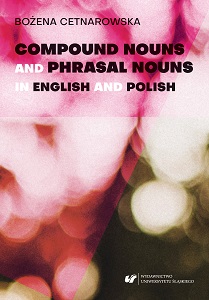Compound nouns and phrasal nouns in English and Polish
Compound nouns and phrasal nouns in English and Polish
Author(s): Bożena Cetnarowska
Subject(s): Language and Literature Studies, Theoretical Linguistics, Applied Linguistics
Published by: Wydawnictwo Uniwersytetu Śląskiego
Keywords: compound nouns; juxtapositions; classifying adjectives; Construction Grammar;Construction Morphology;
Summary/Abstract: The present monograph discusses compound nouns and juxtapositions (i.e., phrasal nouns) in Polish and English, focusing on the interaction and competition between the processes of coining both types of linguistic units. The phrasal nouns under analysis include combinations of classifying adjectives and nouns in any order, for instance, English electrical engineer, hard disk, Polish inżynier budowlany ‘construction engineer,’ zimowe opony ‘winter tyres’; coordinate noun-noun juxtapositions, such as Polish torba-worek ‘holdall bag,’ kelner-barman ‘waiter and bartender’; and combinations of nouns and genitive attributes (English women’s college, Polish dom studenta ‘student hall of residence’). Constraints on forming compound nouns in Polish are illustrated. Compound nouns and phrasal nouns are divided into classes according to the typology of composite expressions postulated by S. Scalise and A. Bisetto. Emphasis is placed on demonstrating that phrasal nouns exhibit a mixture of phrasal and word-like properties. Difficulties are pointed out in drawing a strict and non-arbitrary border between morphological compounds and syntactic phrases, and in identifying subtypes of phrasal nouns which differ in their degree of similarity to regular noun phrases. The phenomenon of univerbation (i.e., morphological condensation) in the Polish language is discussed. The framework adopted in this monograph is the theory of Construction Morphology, formulated by G. Booij, who shows that principles of Construction Grammar can be applied felicitously in the analysis of morphologically complex words. Construction Morphology has been adopted mainly by researchers who study Germanic and Romance languages. In the present monograph construction schemas are proposed for selected types of compound nouns and phrasal nouns in Polish and English. The mechanism of schema unification is employed in order to represent the internal structure of interfixal-suffixal formations in Polish. It is demonstrated that the model of Construction Morphology is particularly felicitous in the study of phenomena at the border of syntax and word-formation, such as interaction and competition between morphological compounds and phrasal lexemes. Although the linguistic data under analysis come mainly from Polish and English, multi-word units from other Indo-European languages are mentioned where appropriate. Theoretical considerations are supported by numerous examples culled from on-line corpora, such as the Corpus of Contemporary American English (COCA) and the National Corpus of Polish (NKJP).
Series: Językoznawstwo
- E-ISBN-13: 978-83-226-3640-4
- Print-ISBN-13: 978-83-226-3639-8
- Page Count: 246
- Publication Year: 2019
- Language: English
- eBook-PDF
- Table of Content
- Introduction

